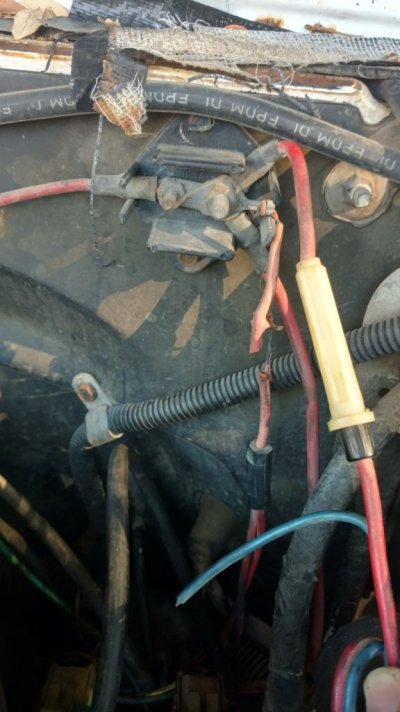I'm including what I did to correct the wiring so I could safely wire the Amp gauge then you'll get to see what I found better.
You must be registered for see images attach
In the pic above, up on the junction box you'll see one #10 red wire, the one that's just below the #10 red wire with the ring terminal right now unattached, on it. That red wire is the original starter power wire that has been on this junction box since I bought the truck. But what I discovered is the factory put the junction box on backwards from how it's shown in the schematic. That was the first thing. The #10 red wire up there with the ring terminal on it is in the correct position to be installed except I'll have to flip the junction box if this wiring is going to be done right, and the fusible link to work like it's designed to work. So that's that.
You must be registered for see images attach
It's easier to show this in the pic above. The #10 wire that's curving at the bottom of the picture is the other end of that starter power wire. In the schematic that 1/4" stud, on the junction box above, is supposed to be on the other side, and the #10 screw, the little screw in the junction box is supposed to be on your right, so you can be correctly oriented. When the junction box is turned correctly that starter power wire will be on the other side, or on your left, of the junction box on the 1/4" stud. The black #10 wire, the second wire above that's on the 1/4" stud now will go with the starter power wire over to your left with the new location of the 1/4" stud.
That front wire, in the pic above is the Alternator power wire. When the junction block is turned over, it will go on the little #10 screw which will be on the right side of the junction box. Then there will be 12v power on both sides of the fusible link, 12v battery power going through the starter power wire on one side, and 12v Alt. power on the other side. And according to the schematic that's the correct way to wire it, 12v power on both sides of the fusible link.
If it blows, once fixed in it's new configuration, the battery will eventually die because the Alt. would have stopped charging. Your volt meter in the cab would show no charge and would be indicating battery voltage only. If you had a amp meter it would peg to discharge.
The factory had it wrong. And I messed things up even more by doing something I'll explain in the next pic.
And the next pic I hope won't be to confusing.
You must be registered for see images attach
This is the way the wires are currently. Let's take this one area at a time and that will clear up any confusion. Look at the junction box only. That orange wire with the 20 amp fuse holder on it doesn't even belong there and I have no idea what or why I put it there!
And here's something for you all; There is no way the fusible link will ever work in it's current configuration! Unless the blower fan shorted out and jammed and there was some other kind of situation, that fusible link would never blow and the truck would probably burn, God forbid! So, it is going to be removed and is going back to where it's supposed to go back inside the cab with the other fan wiring. So on the junction box up there the red #10 wire in the back comes over to the left side, after I flip the box around and the 1/4" stud is on the left. And that #10 black wire up there also comes to the left side of the link as well. That will put power on one side of the fusible link. That black #10 wire is one side of the Amp gauge wiring and it's okay for it to be there with the starter power wire and as a matter of fact that's the way the Autometer instructions says it's to be.
Now let's move down to the block, below the junction box, that I made that has all the wiring on it. This is the simplest of all, it stays just like it is. And it is correctly wired for the Amp gauge. You'll see there are two #10 red wires just above the "S". One is the starter power wire in the back of those two, and the #10 red wire in front is the other wire that goes to the Amp gauge and it's just like the instruction say and it will stay right there.
So that's weird isn't it that that's two screw up's is on GM for something important for this truck to be worked on in the future. I'd tell you about the third screw up on GM where wiring is messed up but I'll hang onto that for some later date. I'll give you a hint, it involves the wiring junction block on the firewall down there where the wires go into the cab, and what happens when it goes inside to the fuse block! What I found is enough to cause you to have nightmares! Ha, ha, ha!



